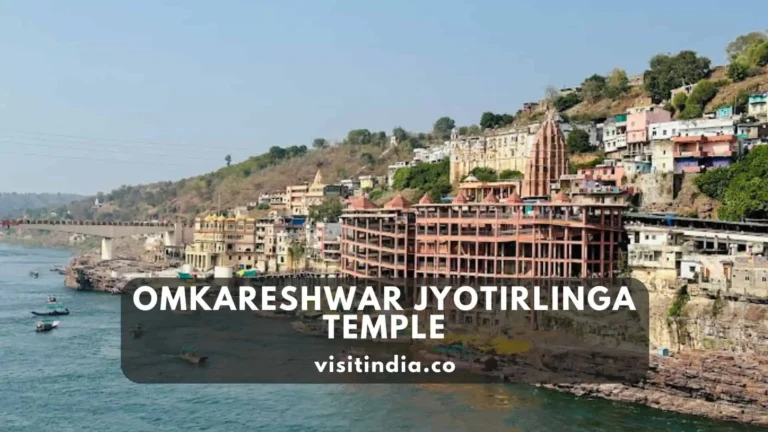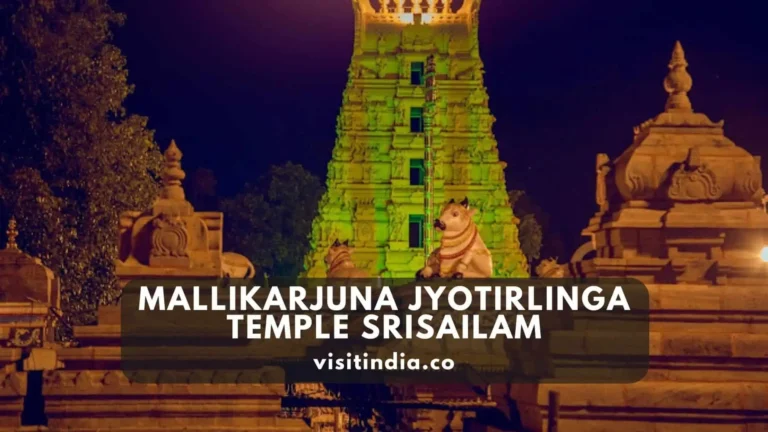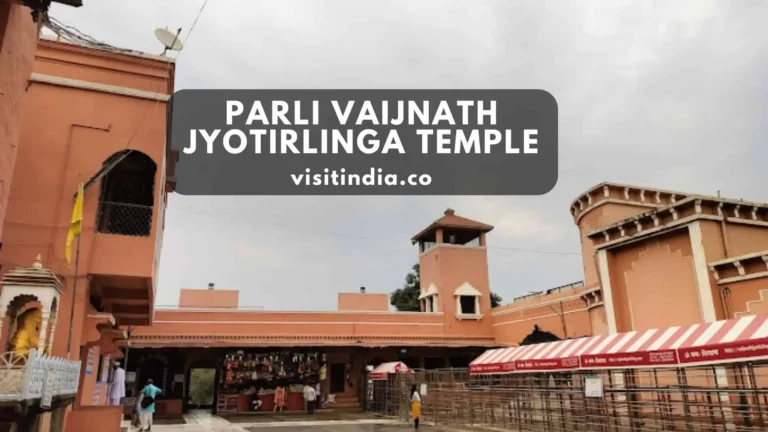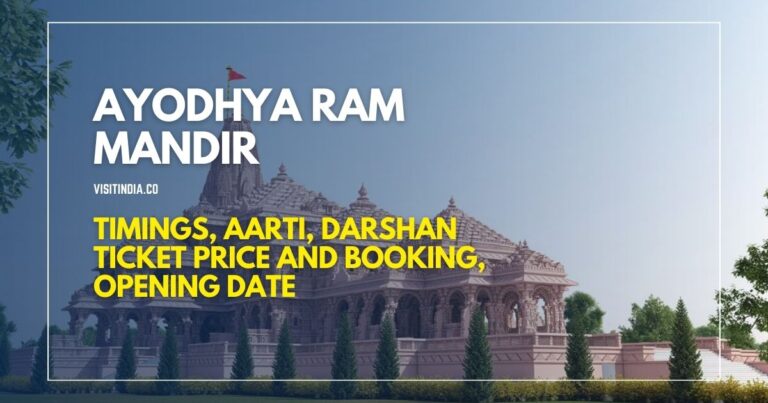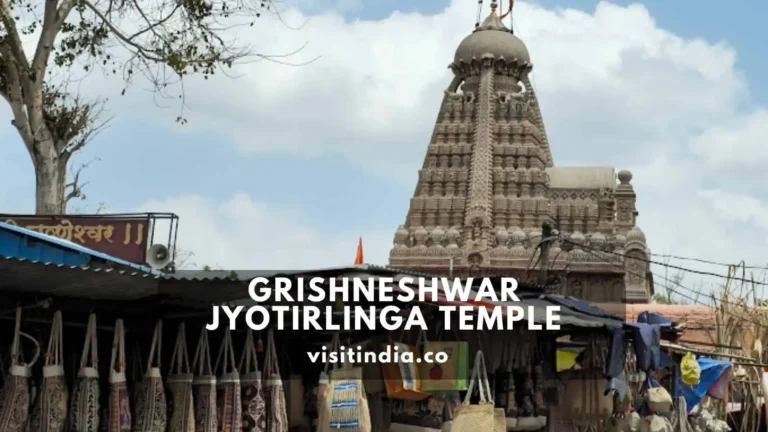Meenakshi Amman Temple: Timings, Tickets, History and Details
The Meenakshi Amman Temple in Madurai is a stunning masterpiece of Dravidian architecture, dedicated to Goddess Meenakshi and Lord Sundareswarar. Renowned for its towering gopurams and intricate carvings, it stands as a symbol of cultural heritage and spiritual devotion.
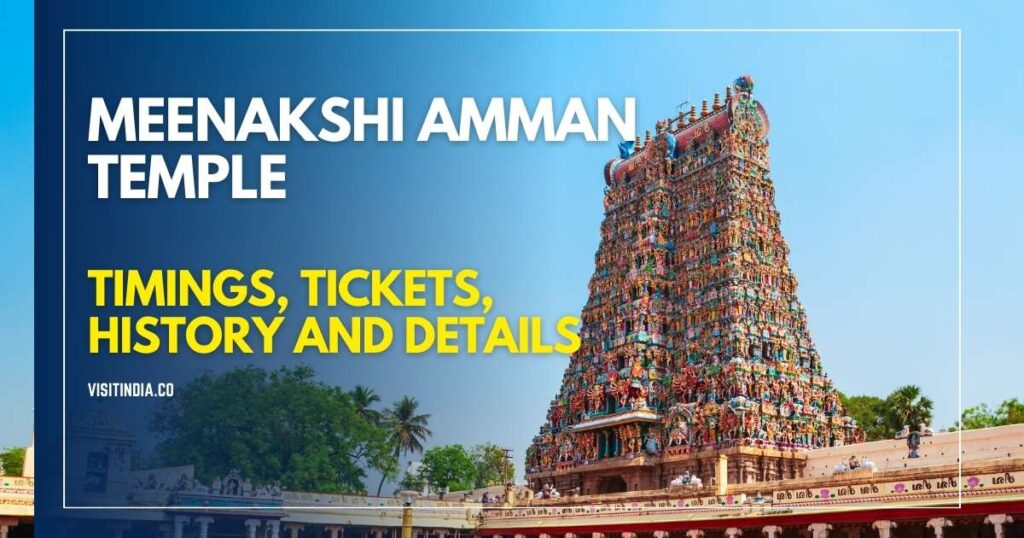
This guide offers essential details to plan your visit, including temple timings, ticket information, and a glimpse into its rich history. Learn about the temple’s architectural marvels and the vibrant festivals that bring it to life.
Whether you’re seeking divine blessings or exploring Tamil Nadu’s cultural treasures, this article provides everything you need to experience the grandeur of the Meenakshi Amman Temple.
See also: Sabarimala Ayyappa Temple: Opening Dates, Timings, Ticket Booking, Route and History
Meenakshi Amman Temple Timings
The Meenakshi Amman Temple in Madurai operates daily with specific timings to accommodate devotees and visitors.
Opening and Closing Hours
The temple opens its doors early in the morning and remains accessible until late evening. The general schedule is as follows:
- Morning: Opens at 4:30 AM and closes at 12:30 PM.
- Evening: Reopens at 4:00 PM and closes at 10:00 PM.
These timings allow devotees to participate in various rituals and offer prayers throughout the day.
Best Time to Visit
For a serene experience with fewer crowds, early mornings are ideal. Arriving around 5:00 AM provides a tranquil atmosphere, enabling visitors to appreciate the temple’s spiritual ambiance and architectural beauty without the usual hustle. Evenings, especially after 8:00 PM, also offer a relatively peaceful environment.
Special Timings
During significant festivals, the temple adjusts its operating hours to accommodate the influx of devotees. For instance, during the Chithirai Festival in April, celebrating the divine marriage of Meenakshi and Sundareswarar, the temple may extend its hours to facilitate various ceremonies and increased visitor numbers.
It’s advisable to check the temple’s official announcements or contact authorities for precise timings during such events.
Meenakshi Amman Temple Tickets, Entry Fee, and Booking Process
The Meenakshi Amman Temple in Madurai is a revered destination for both devotees and tourists. Here’s essential information regarding entry fees, booking procedures, and special darshan options:
Entry Fee
- Indian Visitors: There is no entry fee for Indian nationals; they can access the temple premises free of charge.
- Foreign Visitors: A nominal entry fee of ₹50 per person is applicable. This fee grants access to most areas of the temple complex, including the “Hall of Thousand Pillars” and the museum. However, non-Hindus are restricted from entering the inner sanctums.
Online Booking
As of now, the temple does not offer an online booking facility for darshan or entry tickets. Visitors are required to purchase tickets upon arrival at the temple premises.
Queue and VIP Darshan
- Special Darshan Tickets: For those seeking expedited access, the temple provides special darshan tickets priced at ₹100 per person. These tickets allow visitors to join a faster queue, significantly reducing waiting time.
- VIP Darshan: The temple offers VIP darshan options, with varying costs reported between ₹500 and ₹15,000. These packages may include additional privileges, but specific details are best obtained directly from the temple authorities upon arrival.
Special Packages
While the temple itself doesn’t provide official guided tours or VIP packages, several private tour operators offer comprehensive packages that include guided tours, special darshan arrangements, and other amenities. It’s advisable to research and book these services through reputable providers to ensure a fulfilling experience.
In summary, while the Meenakshi Amman Temple facilitates both free and special entry options to accommodate various visitor preferences, it’s recommended to verify the latest details directly with temple authorities or trusted tour operators before planning your visit.
Important Rituals and Ceremonies at Meenakshi Amman Temple
The Meenakshi Amman Temple in Madurai is renowned for its elaborate rituals and ceremonies, which are integral to its spiritual ambiance. Here’s an overview:
Daily Poojas
The temple conducts several poojas daily, each with its unique significance:
- Thiruvanandal Pooja: Performed between 5:00 AM and 6:00 AM, this ritual marks the opening of the temple and the awakening of the deities.
- Vizha Pooja: Held from 6:30 AM to 7:15 AM, it involves offerings and prayers to the deities.
- Kalasandhi Pooja: Also conducted between 6:30 AM and 7:15 AM, focusing on specific rituals.
- Thrikalasandhi Pooja: Takes place from 10:30 AM to 11:15 AM, involving midday offerings.
- Uchikkala Pooja (Noon Pooja): Occurs between 10:30 AM and 11:15 AM, marking the midday worship.
- Maalai Pooja: Conducted from 4:30 PM to 5:15 PM, signifying evening prayers.
- Ardhajama Pooja (Night Pooja): Held between 7:30 PM and 8:15 PM, preparing the deities for rest.
- Palliarai Pooja: The final ritual from 9:30 PM to 10:00 PM, symbolizing the deities’ retirement for the night.
Each pooja includes abhisheka (sacred bath), alangaram (decoration), neivethanam (food offerings), and deepa aradanai (lamp ceremony).
Special Ceremonies
Beyond daily rituals, the temple hosts special ceremonies:
- Monthly Festivals: Each Tamil month features unique festivals, such as the Vasantham festival in Vaikasi and the Unjal Festival in Aani.
- Annual Celebrations: Major events like the Meenakshi Thirukalyanam during Chithirai and Navaratri in Purattasi are celebrated with grandeur.
These ceremonies often involve elaborate processions, cultural performances, and community participation, enhancing their significance.
Participation
Visitors can engage in these rituals in various ways:
- Observing Poojas: Attendees can witness the poojas from designated areas, experiencing the spiritual atmosphere firsthand.
- Offering Prayers: Devotees may offer personal prayers and donations during rituals.
- Special Darshan: The temple offers special darshan tickets, such as a ₹100 premium ticket for faster access.
- Booking Poojas: Certain poojas can be booked in advance, allowing devotees to participate more intimately.
It’s advisable to check with temple authorities for specific guidelines and availability regarding participation in rituals and ceremonies.
History of Meenakshi Amman Temple
The Meenakshi Amman Temple in Madurai, Tamil Nadu, stands as a testament to India’s rich cultural and architectural heritage. Its origins trace back over two millennia, with significant contributions from various dynasties shaping its grandeur.
Origins
Historical accounts suggest that the temple’s earliest structures were commissioned by the Pandya king, Kulasekara Pandya, around the 6th century CE. He is credited with constructing portions of the three-storeyed gopuram at the entrance of the Sundareswarar Shrine and central parts of the Meenakshi Shrine.
Over time, successive rulers, including the Nayak dynasty in the 16th and 17th centuries, expanded and enhanced the temple complex, contributing to its current magnificence.
Architecture
The temple exemplifies Dravidian architecture, characterized by its intricate designs and towering structures. Spanning approximately 14 acres, the complex is enclosed by high walls and features a mandala layout, symbolizing cosmic harmony.
Among its most striking features are the 14 gopurams (gateway towers), adorned with thousands of colorful sculptures depicting deities, mythical beings, and legends. The tallest, the southern gopuram, rises over 170 feet.
Inside, the temple houses the renowned “Hall of Thousand Pillars,” each pillar intricately carved, showcasing the artisans’ exceptional skill.
Historical Events
Throughout its history, the Meenakshi Amman Temple has witnessed numerous significant events. In the early 14th century, it suffered destruction during Malik Kafur’s invasion, leading to a period of decline.
However, the Vijayanagara Empire initiated restoration efforts in the 16th century, reviving the temple’s prominence. The temple also serves as the focal point for the annual Meenakshi Tirukalyanam festival, attracting millions of devotees who celebrate the divine marriage of Meenakshi and Sundareswarar.
Renovations and Expansions
The temple has undergone several renovations to preserve its splendor. Notably, in the 16th century, the Nayak rulers, particularly Vishwanatha Nayakar, expanded and fortified the complex, adding new structures and enhancing existing ones.
In recent times, conservation efforts have focused on maintaining the temple’s structural integrity and artistic heritage, ensuring that this architectural marvel continues to inspire awe for generations to come.
Meenakshi Amman Temple Rules and Dress Code
Visiting the Meenakshi Amman Temple in Madurai requires adherence to specific guidelines to maintain the sanctity of this revered site. Here’s what visitors need to know:
Dress Code
- Men: Traditional attire such as dhotis or veshtis paired with shirts or kurtas is recommended. Avoid shorts, lungis, or sleeveless tops.
- Women: Sarees, salwar kameez, or long skirts with appropriate tops are preferred. Clothing should cover the shoulders and knees, avoiding sleeveless or tight-fitting garments.
- Children: Ensure attire is modest and covers the body appropriately.
While the temple may not enforce a strict dress code, dressing conservatively shows respect for the religious customs.
Prohibited Items
- Electronic Devices: Mobile phones, cameras, and other electronic gadgets are not permitted inside. Secure storage facilities are available near the entrance.
- Footwear: Shoes must be removed before entry. Designated areas are provided for footwear storage.
- Other Items: Food, beverages, and any items deemed inappropriate by temple authorities are prohibited.
These measures help preserve the temple’s sanctity and ensure a serene environment.
Photography and Videography
Capturing photos or videos within the temple premises is strictly forbidden. This policy respects the spiritual atmosphere and the privacy of worshippers.
Behavioral Guidelines
- Conduct: Maintain silence and avoid disruptive behavior. Engage in conversations softly to uphold the temple’s tranquil ambiance.
- Respect: Follow instructions from temple staff and respect all rituals and customs.
- Queue Discipline: Adhere to designated lines and wait patiently for darshan (viewing of the deity).
How to Reach Meenakshi Amman Temple
The Meenakshi Amman Temple in Madurai is accessible through various modes of transportation:
By Air
The nearest airport is Madurai International Airport (IXM), located approximately 12 kilometers (7.5 miles) from the temple. This airport offers regular flights connecting major Indian cities such as Chennai, Bangalore, Mumbai, and Delhi. Upon arrival, visitors can hire taxis or auto-rickshaws to reach the temple, with the journey typically taking around 20–30 minutes, depending on traffic.
By Train
Madurai Junction Railway Station is the closest railhead, situated about 2 kilometers (1.2 miles) from the temple. It serves as a major hub, with trains arriving from various parts of India. From the station, visitors can opt for auto-rickshaws or taxis to reach the temple, a trip that usually takes around 10 minutes.
By Road
Madurai is well-connected by road to cities across Tamil Nadu and neighboring states. The city’s central bus stand, Periyar Bus Stand, is approximately 1 kilometer (0.6 miles) from the temple. State-run and private buses operate frequently to and from Madurai. For those traveling by private vehicle, the temple is accessible via National Highways NH44 and NH38. Parking facilities are available near the temple complex.
Local Transport
Within Madurai, visitors have several options:
- Auto-Rickshaws: Widely available and convenient for short distances. It’s advisable to negotiate fares beforehand or ensure the meter is used.
- Taxis: Offer a comfortable alternative for getting around the city. Services can be booked through local operators or ride-hailing apps.
- Buses: The local bus network connects various parts of the city, with stops near the temple. This is an economical choice, though buses can be crowded during peak hours.
- Walking: If staying nearby, walking to the temple is feasible and allows for an immersive experience of the city’s vibrant streets.
In summary, reaching the Meenakshi Amman Temple is straightforward, with multiple transportation options catering to different preferences and budgets. Planning ahead and choosing the most suitable mode of transport can enhance the visit to this iconic landmark.
Festivals and Celebrations at Meenakshi Amman Temple
The Meenakshi Amman Temple in Madurai is renowned for its vibrant festivals, which draw devotees and tourists alike. Two of the most significant celebrations are the Meenakshi Thirukalyanam and Navaratri.
Major Festivals
- Meenakshi Thirukalyanam (Celestial Wedding): Celebrated during the Tamil month of Chithirai (April), this festival marks the divine marriage of Goddess Meenakshi and Lord Sundareswarar (Shiva). Spanning 12 days, it is a highlight of the Chithirai Festival, uniting devotees in joyous festivities.
- Navaratri: Observed over nine nights, typically in September or October, Navaratri honors the divine feminine energy. At the Meenakshi Temple, each day features the goddess adorned in different attire, with special rituals and cultural events enhancing the spiritual atmosphere.
Festival Activities
- Processions: Both festivals feature grand processions where deities are paraded through the streets on elaborately decorated chariots, accompanied by music and dance, creating a festive ambiance.
- Pujas and Rituals: Special ceremonies, including the exchange of garlands during Meenakshi Thirukalyanam and daily alankarams (decorations) during Navaratri, are performed to honor the deities.
- Cultural Programs: Classical music and dance performances are organized, showcasing the rich cultural heritage of Tamil Nadu.
Significance of the Festivals
These celebrations hold profound importance for locals and devotees:
- Spiritual Significance: They commemorate divine events, reinforcing religious beliefs and traditions.
- Cultural Unity: The festivals bring together diverse communities, fostering social harmony and collective participation.
- Economic Impact: The influx of visitors boosts local businesses, contributing to the region’s economy.
See also: Maha Kumbh Mela 2025: Date, Place, Snan, Tents Details
Nearby Attractions From Meenakshi Amman Temple
Madurai, often referred to as the “Athens of the East,” is rich in cultural and historical landmarks surrounding the Meenakshi Amman Temple. Here’s a curated list of nearby attractions and day trip suggestions:
Other Temples
- Koodal Azhagar Temple: Located approximately 1 kilometer from Meenakshi Amman Temple, this ancient temple is dedicated to Lord Vishnu. It’s renowned for its intricate architecture and the unique depiction of Vishnu in three postures: sitting, standing, and reclining.
- Thirupparamkunram Murugan Temple: Situated about 8 kilometers from the city center, this temple is one of the six abodes of Lord Murugan. Carved out of a hill, it showcases rock-cut architecture and holds significant religious importance.
Tourist Spots
- Gandhi Memorial Museum: Approximately 2.5 kilometers from Meenakshi Amman Temple, this museum offers insights into India’s freedom struggle and houses personal artifacts of Mahatma Gandhi.
- Thirumalai Nayakkar Mahal: Located around 1.5 kilometers away, this 17th-century palace exemplifies Indo-Saracenic architecture. Visitors can explore its grand courtyards and marvel at the intricate stucco work.
Day Trip Ideas
- Alagar Kovil and Pazhamudircholai Murugan Temple: Situated about 21 kilometers from Madurai, Alagar Kovil is a temple dedicated to Lord Vishnu, nestled in the Alagar Hills. A short drive further leads to Pazhamudircholai, another of Lord Murugan’s six abodes, surrounded by lush forests.
- Samanar Hills: Approximately 10 kilometers from the city, these hills feature ancient Jain caves and carvings, offering panoramic views of Madurai and a glimpse into the region’s Jain heritage.
- Kodaikanal: Located about 120 kilometers from Madurai, this hill station is known for its cool climate, scenic landscapes, and attractions like the Kodaikanal Lake and Coaker’s Walk.
- Rameswaram: Approximately 170 kilometers away, this coastal town is home to the Ramanathaswamy Temple and is considered one of the holiest places in India.
- Chettinad: Around 90 kilometers from Madurai, Chettinad is famed for its unique cuisine, grand mansions, and rich cultural heritage.
These destinations offer a diverse experience, from spiritual enrichment to cultural exploration, all within accessible distances from the Meenakshi Amman Temple.
